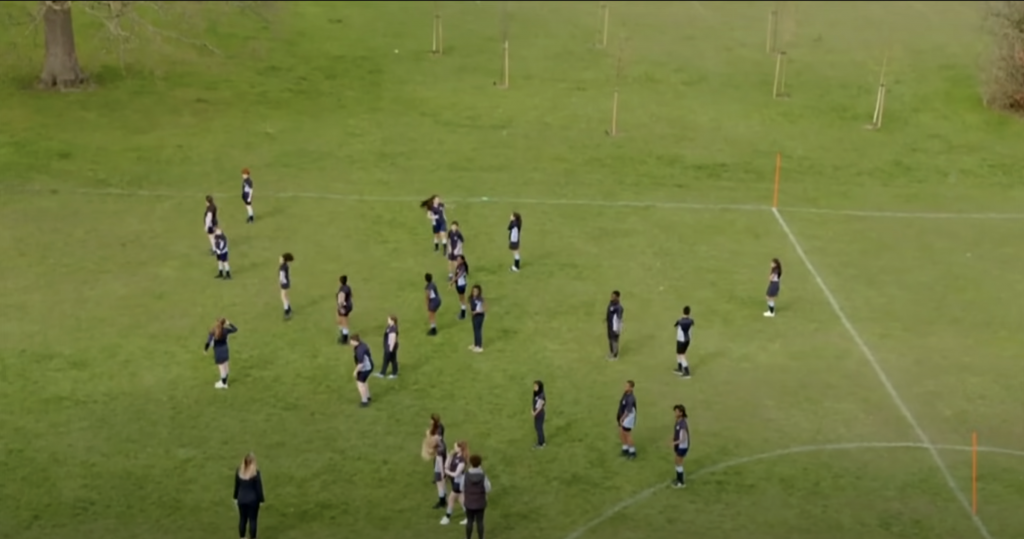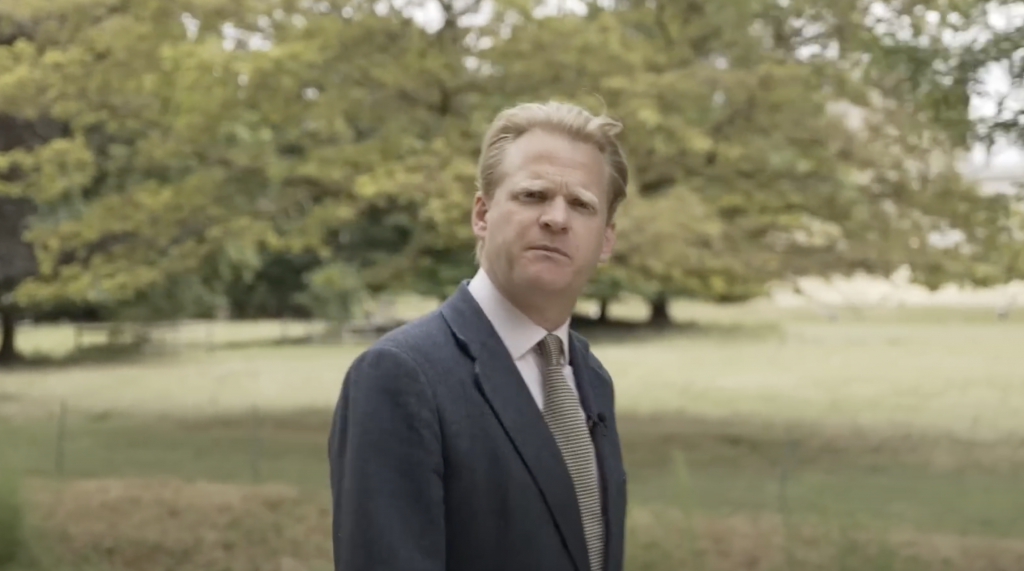Something that stands out is that those currently being effected (and measured) by diversity issues in education (students) aren’t driving the conversation in the three video segments highlighted. While the medium’s constraints are part of the reasons for this, it still makes me think about the ongoing challenges around who gets heard and the need for polyphonic, intergenerational conversations.
The School That Tried to End Racism (Channel 4)
In the featured activity in the video segment from Channel 4, questions about cultural privilege are asked before a race and each child moves a step up or back depending on their answer.
This game seems both potentially empowering and harmful to the participants. By acting out part of their lived experiences, they are given an opportunity to see themselves and their peers differently, but it could also run the risk of harming the self-esteem of the young participants. The positionally is less specific to pin down than the other videos – being a media company. I assume, being a large organisation, they had to go through a long process of getting appropriate perspectives and permissions, but aspects of this come off a little bit like a detached scientist in a lab performing an experiment. The story’s gaze is at times framed from above, running a risk of othering those involved.

That said, it was a moving, emotionally impactful piece, and I can safely assume that the creators believe in changing institutional norms around diversity.
Something unquestionably positive from this video is that the children are clear that this scenario isn’t fair and that they don’t think things should be done this way.
The charity turning UK universities woke (Orr).
James Orr is an adult, white British male who teaches at Cambridge University. He claims that AdvanceHE is the primary body attempting to decolonise universities and that they are pushing an agenda that the vast majority of the public would not support or agree with. But he does so without any evidence or context to back up this opinion. He mainly focusses on what he sees as a negative impact of AdvanceHE. He doesn’t really mention any outside sources for the data he mentions in the video and only includes other male colleagues at Cambridge. He often seems antagonistic in his demeanour and is leading with his questions to student.

Also, he is in a position of power as a white teacher interviewing non-white students at the same university. How comfortable would students feel? Admirably, they appear to speak honestly despite this uncomfortable situation. Generally speaking, this should be a conversation and not an interrogation to be fair and productive.
Orr poses the notion of a current battle between excellence and ideology…but excellence in itself is part of an ideology. He ignores or is blind to this fact. When he talks about excellence, we can only assume he is referring to an idea that has been formed from within the historically dominant, white, British male worldview that has been cultivated for centuries in elite academic institutions like Cambridge.
Diversity, Equity & Inclusion. Learning how to get it right. Asif Sadiq. TEDxCroydon (Sadiq)
As is discussed in the video, money is not driving the change people want to see. Why? The diversity training is built with bias (Sadiq).
“The assumption is, everyone learns the same way – everyone absorbs information the same way…but we know that’s not true” (Sadiq). As someone with ADHD, I often find myself desperate to have managers and co-workers to embrace this idea in the workplace. But it is hard. From my experience teaching so far, I have been surprised that this is not more widely understood and embedded in the learning culture of UAL.
Another kind of bias that Asif Sadiq explores is an over-emphasis on the negative framing of challenges that underrepresented group face. Sadiq says, “A lot of our diversity training…looks at some of the challenges faced by some of these communities…rightfully so…however, it is not all misery. There are so many successes in diverse communities…in underrepresented groups. Why don’t we hear about them?” I believe this kind of tonal shift is crucial. Similar to ways that a colonialist mindset cultivates an “othering” worldview, this negative-centric distanced viewing of people and their challenges skews the dynamic, innovative experience of a community. Simply put, celebrate the successes!
Another example of bias Sadiq talks about is the tendency to apply dominant perspectives to diversity training with a focus on scaling our approach to make it universal. But “diversity is different in each and every country…in each and every town…each and every block…[we need to]…diversify the content we teach. Localise it – not design it centrally” (Sadiq).
In the course I teach at LCC, the MA Design for Data Visualisation, one of the foundational texts we explore is Data Feminism. A central principle of the manifesto-style book is that we need to embrace complexity when designing and communicating data. To me this parallels Sadiq’s sentiment that one size does not fit all and that “we learn through stories…we need more stories and human interaction.” Stories are dynamic. They are a powerful vessel for communicating and understanding complex experiences. We should continue to lean on experienced based learning and storytelling to traverse statistical, categorical boundaries because as Sadiq points out, “experiences are powerful. [That’s] how we learn. So if we are going to see teach people about diversity, we need to allow them to experience it.”
References
Bradbury, A., 2020. A critical race theory framework for education policy analysis: The case of bilingual learners and assessment policy in England. Race Ethnicity and Education, 23(2), pp.241-260.
Channel 4. (2020) The School That Tried to End Racism. [Online]. Youtube. 30 June. Available at: https://www.youtube.com/watch?v=1I3wJ7pJUjg
D’Ignazio, C. and Klein, L.F. (2020) Data Feminism, The MIT Press. Available at: https://data-feminism.mitpress.mit.edu
Garrett, R. (2024). Racism shapes careers: career trajectories and imagined futures of racialised minority PhDs in UK higher education. Globalisation, Societies and Education, pp.1–15.
Orr, J. (2022) Revealed: The charity turning UK universities woke. The Telegraph [Online]. Youtube. 5 August. Available at: https://www.youtube.com/watch?v=FRM6vOPTjuU
Sadiq, A. (2023) Diversity, Equity & Inclusion. Learning how to get it right. TEDx [Online]. Youtube. 2 March. Available at: https://www.youtube.com/watch?v=HR4wz1b54hw
One response to “Blog Task 3: Race”
Jesse – this is an excellent and very insightful blog post. I found the film ‘The School that Tried to End Racism’ affecting too, and although it felt like it could be running close to the line between being harmful or empowering, I agree and think the filmmakers heart was in the right place. Unfortunately, the comments section of the film revealed a lot of people seemed to miss the point of the exercise, which I guess shines a light on how much change needs to happen.
The James Orr piece was something else. In trying to make a piece exposing Advance HE’s WOKE agenda, he actually reveals himself to be part of the problem, i.e., the white power structure who wants to resist change and retain the status quo. How figures of seniority were cherry picked to support his viewpoint was, at best, laughable. Of course, with him being a renowned right-wing commentator making a film for The Telegraph, I’d have expected nothing less, but it was a depressingly obvious film playing for a target audience.
Your comments on Asif Sadiq’s Ted talk are powerful, and totally support his point of view on diversifying Diversity trainers to include more people with experiences Students can directly relate to, especially as someone with ADHD. I too loved his reflection that ‘we learn through stories’ and that people need to also see diversity too if they’re to learn about it.